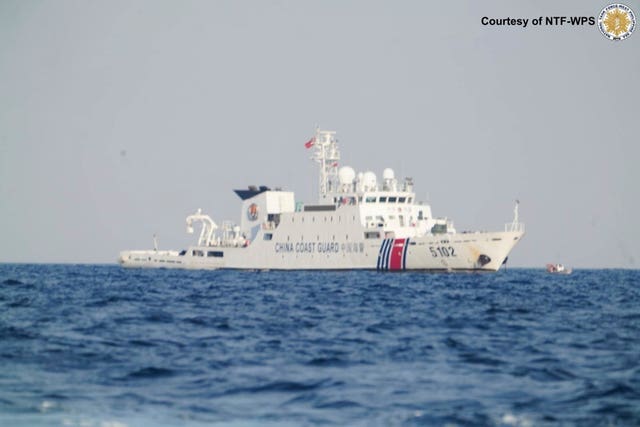China and Philippines use flags to stake competing claims in South China Sea
The two countries have previously jostled over Sandy Cay, known as Tiexian Reef in Chinese and Pag-asa Cays in the Philippines.

The Philippines has rejected China’s claim to a group of three sandbars in the South China Sea, after recent displays by both sides of their national flags on the uninhabited outcrops.
The back and forth over Sandy Cay is the latest flare-up in a long-running dispute over territory in the hotly contested South China Sea, which China claims almost in its entirety.
The flare-up began last week when a Chinese state-owned newspaper posted exclusive photos of coast guard officers on Sandy Cay from mid-April, including one of them holding up a Chinese flag.
Three days later, on Sunday, a joint Philippines coast guard, navy and maritime police team headed to the three sandbars and posed for a photo holding up their national flag.
A government statement said: “This operation reflects the unwavering dedication and commitment of the Philippine Government to uphold the country’s sovereignty, sovereign rights and jurisdiction in the West Philippine Sea.”
It was posted on social media site X with a video and photos, including one showing team members holding up the Philippine flag.

The Chinese coast guard described the Philippine landing as “illegal” and said Chinese officers had gone ashore “to conduct on-site verification and enforcement measures”. It did not specify what those steps entailed.
The sandbars are in the Spratly Islands, between Philippine-occupied Thitu Island and Subi Reef, which China has transformed into a base with a military-grade runway and buildings with communications facilities.
China’s state-owned Global Times newspaper, which published the photos of coast guard officers on the sandbars earlier this month, said they had picked up plastic bottles and other debris and displayed the Chinese national flag “to assert sovereignty”.
Jonathan Malaya, assistant director-general of the Philippine National Security Council, said on Monday that there is no truth to claims that China has seized the sandbars.
He attributed the claims to the Chinese coast guard, though the agency has not said anything about the mid-April landing described in the Global Times report, and later by the military channel of state broadcaster CCTV.
“We urge the People’s Republic of China and the Chinese Coast Guard to act with restraint and not increase tensions in the West Philippine Sea,” Mr Malaya told a news conference,
The two countries have previously jostled over Sandy Cay, known as Tiexian Reef in Chinese and Pag-asa Cays in the Philippines.
In January, the Chinese coast guard and a naval helicopter drove away a group of Philippines fisheries ships that were attempting to conduct a scientific survey around Sandy Cay.
Philippine government vessels took scientists to Sandy Cay in March last year for marine research despite repeated warnings by Chinese coast guard ships.
Chinese officials accused the Philippine military of attempting to build a structure on one of the sandbars in 2017.





